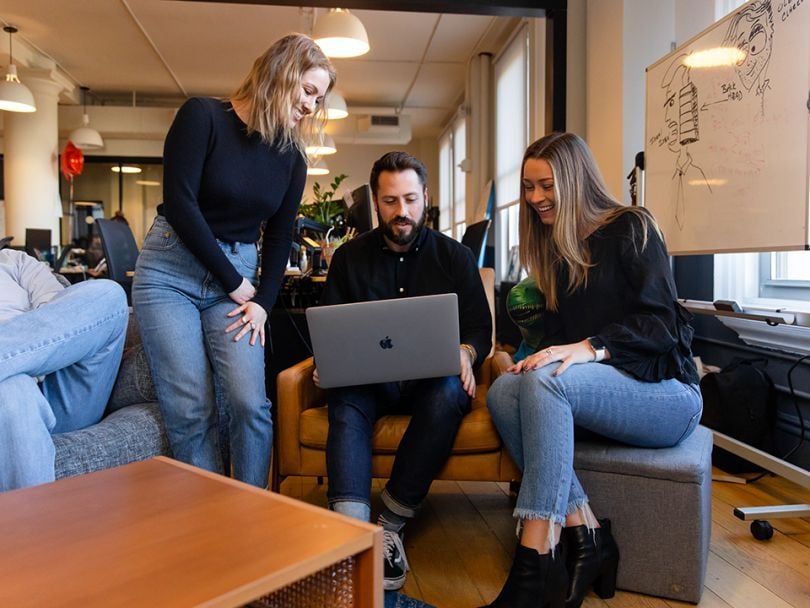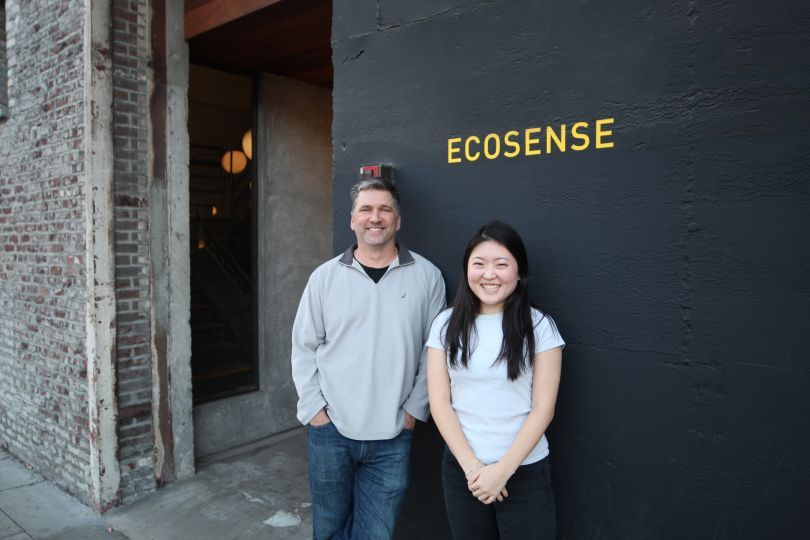The average person spends over four hours on their phone each day, according to a recent study from Nielsen.
Michelle Fork, a product designer at Hinge, wants to change that.
“We want our users to use Hinge to make meaningful connections and then get off the app,” Fork said. To her, good design includes a social responsibility that does not encourage users to feed their digital addictions.
Both Fork and Anne Marie Leahey, a senior user experience design consultant at Kin + Carta, agreed that designers need to collaborate with developers and harness user insights to achieve ideal UX design experiences. As well, they are prioritizing accessibility and inclusive design to reach a wide range of users.
We picked designers’ brains on the major UX design trends they’re watching in 2020. They shared what technologies they’re excited about and how they’ll be incorporating them into their products and features in the future.
Design Trends To Watch
- Digital Wellness
- Inclusive Design
- Voice & Motion-Enabled Control
- Contextual UX
- AI and Machine Learning in Design

Hinge
Hinge is a dating app designed to get people offline and spending more time on actual dates. To incorporate that mission into UX design, Michelle Fok, product designer, focuses on design inclusivity, which means considering all different types of users and being extra sensitive to blind spots and biases.
What UX design trends are you watching in the year ahead and why do you think these trends will be important?
The two that are top of mind are digital wellness and inclusive design. As users become more aware of their relationship with their phones, we have a social responsibility to make sure we’re building products that aren’t feeding into digital addiction. Being inclusive in our designs means we’re considerate of all of our users and extra sensitive to blind spots and biases we might have.
"We want our users to use Hinge to make meaningful connections and then get off the app.’’
How do you plan to incorporate these UX trends into the products/features your team is building in 2020?
For digital wellness, we really want to live up to our brand mission of “designed to be deleted.” We want our users to use Hinge to make meaningful connections and then get off the app. More time on dates and less time on the app — that is what’s grounding our focus for the features we want to ship this year.
We’ll be able to further incorporate inclusive design decisions as we collaborate with more teams that have insights into real user sentiment. I’m excited to be working more closely with our newly formed community and research labs teams this year. With these resources, we’ll be able to gain better insight into the ever-changing state of modern dating.

Kin + Carta
Kin + Carta works with Fortune 500 companies to create digitally transformative solutions, always with a focus on the end-user's experience. Senior User Experience Design Consultant Anne Marie Leahey said focusing on their users and the craft remains paramount today in good UX design.
What UX design trends are you watching in the year ahead and why do you think these trends will be important?
We’ve arrived at an exciting crossroads where design, strategy, research, business and data are all solidly within the purview of UX. There’s an opportunity for designers to level up their existing knowledge in these areas to be true strategic business partners and apply UX at the highest levels. We have the ability to do this quite naturally, given our instincts for creative, empathetic solutions and the ability to quickly distill complex information and problems — all while remaining the strongest advocate in the room for our users. These dedicated roles have been cropping up for UX strategists and business designers, and we’ll likely continue to see them grow.
Apart from these newly evolving UX roles, a focus on our craft remains paramount. Expertise and finesse in prioritizing accessibility in the products and experiences we create will continue to take center stage.
"Apart from these newly evolving UX roles, a focus on our craft remains paramount.’’
How do you plan to incorporate these UX trends into the products/features your team is building in 2020?
With a focus on prioritizing accessibility in our work, my team has been collaborating closely with our cross-functional teammates to work in an accessibility-first mindset. We’ve also been partnering even closer with our developers to create the best solutions, coded in the smartest ways. We’ve also been practicing what we preach within our internal endeavors, and have put accessibility at the forefront of our exciting work to come throughout 2020.
In terms of continued growth for UX strategist and business designer roles, my team actively defines these roles in the ways we can apply and maximize value for our users and our clients. We’ll continue to refine and iterate how we develop these roles, and prioritize creating pathways and training for designers who want to progress their career paths in this direction.

EcoSense
After lighting hotel lobbies, five-star restaurants and Parisian showrooms, EcoSense Lighting proves that beautiful lighting can also save energy by using LEDs. Jean Kim, UX designer, said that removing the “technology barrier” from its lightning system (i.e. an overwhelming control system) elevates the user experience.
What UX design trends are you watching in the year ahead and why do you think these trends will be important?
UX stands at a crossroads in 2020. Although traditional concepts of users interfacing through a screen may still be a default, new concepts using AR, VR, gesture and audible interaction are becoming more prominent. Samsung has recently upended the entire idea of needing a translation interface with its Neon AI.
The most immediate UX trends for 2020 that we see for connected devices and smart technology is the move toward voice and motion-enabled controls that don’t require touch. With the rise of products like Amazon Alexa and Google Home, the user’s experience no longer begins once they open an app, but from the moment they walk into their home.
"New technology in lighting has created a wide menu of options for control.”
How do you plan to incorporate these UX trends into the products/features your team is building in 2020?
We are creating products that incorporate interaction between the light and the human experience within their physical surroundings with an intermediary control experience that strives to be almost invisible and forgotten by the user in order to direct all attention toward their experience of the light.
New technology in lighting has created a wide menu of options for control that can overwhelm new users. By incorporating more natural interactions we intend to remove the “technology barrier” and give users better access to the capabilities of their lights.

AppOnboard
Not everyone has the time to master programming, but that shouldn’t stop them from using software to build their businesses. Vice President of Creative Doug Manson said he expects to see more companies build no-code software like AppOnboard’s Buildbox, which allows users to easily design mobile apps and games.
What UX design trends are you watching in the year ahead and why do you think these trends will be important?
Currently, within the Buildbox software, we are driving toward this by leveraging one of our newest features, Brainboxes.
Brainboxes are plug-and-play components that a user can add to an object that has predetermined animations and logic. This allows users to quickly and easily create game interactions based on the most common user settings. Heading into 2020, we will be working on adding more predetermined logic into other areas such as physics settings.
As platforms become more personalized and tuned to the individual user, I think we will also see a trend toward human design. More organic shapes, illustrations and empty space coupled with a more conversational and informal tone in messaging will create a friendly approach.
Finally, the shift toward no-code software. With Buildbox and AppOnboard software being part of this movement, I will be watching how others in the no-code space are making design more accessible and inclusive to general audiences. Optimizing UX/UI for people who are not coming from a traditional design background and might be unfamiliar with typical design programs and techniques is hypercritical.
"As platforms become more personalized, I think we will also see a trend toward human design.”
How do you plan to incorporate these UX trends into the products/features your team is building in 2020?
You will start to see us refer to technical terms in more layman's terms throughout the software. These terms will be more relatable to the everyday person, who might not know the differences between kinematic and dynamic physics. Another place you will see us doubling down will be with our Game Wizard.
The Game Wizard guides users through setting up their initial game template and walking them through fundamental key points of complex game mechanics in a simple format. This is especially useful for users who are new to building games.

Weavy
Weavy’s white-label framework allows developers to contextually embed team collaboration, like Google Docs and secure file-sharing, into an app to boost productivity. CTO Linus Birgerstam predicts contextual UX to be a big trend for 2020.
What UX design trends are you watching in the year ahead and why do you think these trends will be important?
I believe there’s an ongoing trend around taking contextual UX beyond bringing data and functionality to mobile devices. Contextual UX in 2020 is about bringing any functionality to anywhere. Truly contextual UX will merge all underlying functionality into any other platform and the user will not feel the difference between the two.
"Contextual UX in 2020 is about bringing any functionality to anywhere.”
How do you plan to incorporate these UX trends into the products/features your team is building in 2020?
Weavy is a white-label collaboration framework that we have built around contextual UX from the start. In 2020, we will focus on saving developers a lot of time by adding our framework to their apps.

Saggezza
“In today’s enterprises, developing an application for a single platform or device is a waste of time and money,” said Saggezza User Experience Practice Manager Richard Alvarez.
Alvarez, who has worked at the digital consultancy for nearly five years, said the key to any tech company finding success hinges on their ability to solve real problems for real people — across all platforms.
To achieve this goal at Saggezza, Alvarez said his team works closely with engineers to understand different platforms, operating systems and device design patterns. Cross-collaboration helps close the knowledge gap for UX professionals while ultimately contributing to the evolution of the company’s digital products.
Richard Alvarez
USER EXPERIENCE PRACTICE MANAGER
 What’s a significant UX design trend you’re focusing on in the year ahead?
What’s a significant UX design trend you’re focusing on in the year ahead?
In today’s enterprises, developing an application for a single platform or device is a waste of time and money. Focusing on the customer experience and developing features that can solve customer issues across all platforms and devices is a trend that more organizations are moving toward. UX focuses on customer needs, not platforms and devices, so we design solutions catered to real people.
However, understanding platforms, operating systems and device design patterns is still essential. This knowledge ensures that we design solutions that are appropriate for the digital deliverable they are intended for and take advantage of all they have to offer.
AI IN UX
Artificial intelligence cannot yet replace the human eye’s ability to curate and create, but it can help make designers more efficient. For example, Airbnb is using the technology to turn pen and paper sketches into code in almost real-time. Meanwhile, Adobe Sensei uses AI to help creatives automate time-consuming tasks and create intuitive cross-platform experiences.
What technologies do you see affecting design in 2020?
Artificial intelligence and machine learning are an integral part of every aspect of digital delivery today. But the power of AI and ML will only be good if end-user and customer solutions stem from usability, convenience and simplicity; or in other words, good user experiences.




